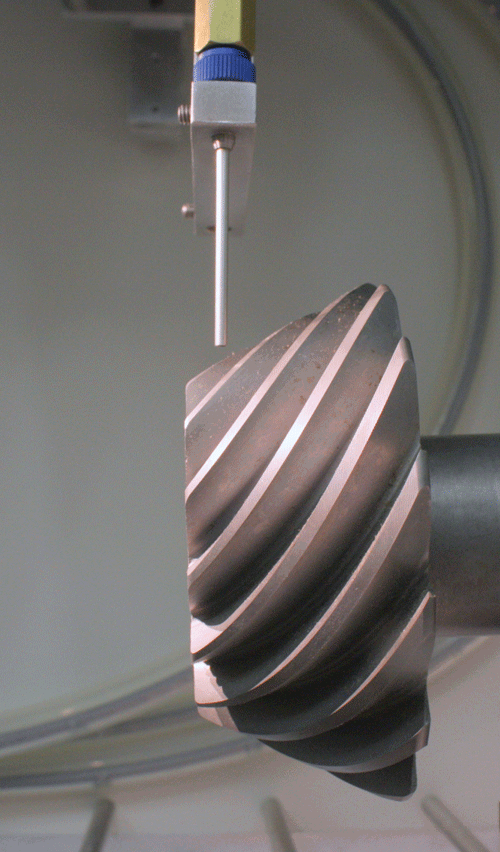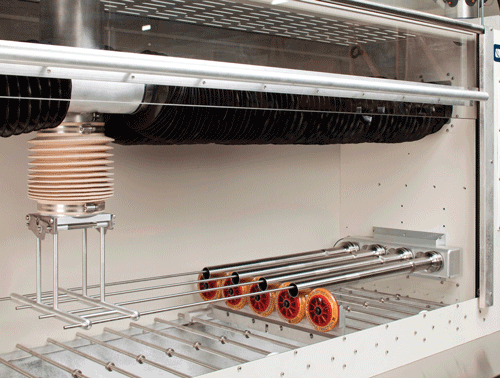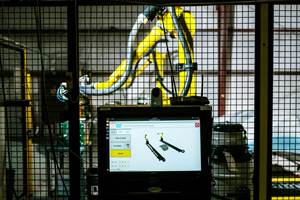Microabrasive Precision Shot Peening
Precision shot peening brings an entirely new concept to the field of microabrasive blasting, and it is complementary to its larger cousin. Using glass bead media, several companies have been shot peening for years with microabrasive blasting technology.
On military vehicles and all types of aircraft, shot peening is used to prevent the formation of fatigue cracks from opening on the material surfaces of parts and on shell surfaces. It also helps prevent corrosion and add wear resistance to any material placed under repeated stress.
Traditionally, this is done using large shot peening systems, where the part to be treated is placed in a chamber and a large nozzle blasts the surface with a wide spray of the selected media (glass bead, ceramic bead, stainless steel, cast steel or cut wire) until the desired result is obtained.
Peening surfaces with glass bead eliminates ferrous contamination and does not leave residue on metal. Conditioned-cut-wire shot peening helps remove sharp edges from material surfaces. In all cases, protecting areas that must not be hit by the media requires applying custom masking or creating special protective fixturing.
Traditional shot peening systems are very large and are steel-reinforced to protect the inside from the random media blast. They also require very large air compressors to operate. They have been doing the job for years, however, and until only recently, as some newer designs in both internal and external parts have made them smaller and lighter, they were sufficient to handle everything.
Microabrasive Blasting Background
Precision shot peening brings an entirely new concept to the field of microabrasive blasting, and it is complementary to its larger cousin. Using glass bead media, several companies have been shot peening for years with microabrasive blasting technology. A major difference with the microblasting approach is that it uses very fine media (150 microns or finer) that can only be used once. Shot peening media is larger and is reclaimed for reuse. However, the theory behind both microblasting and shot peening is basically the same: accurately mixing air and media, and then shooting it at a target part.
Taking the step from microblasting to precision shot peening was a matter of designing a new and larger automated system that can both handle this larger media and recycle it. This has to be done within a larger, automated processing chamber that contains the process and still works with the highly focused precision of an automated lathe microblaster.
Metering exact quantities of media and air is required to ensure the tightest process control. Precision shot peening systems do this by positively introducing media into the air stream, as opposed to methods used by traditional shot peening equipment—gravity, syphoning or magnetic feed systems. A side benefit of more accurate abrasive delivery is the ability to hold tighter-intensity tolerances.
Precision shot peening takes a highly and tightly focused approach to peening. Typical nozzle sizes are 0.060- to 0.185-inch inner diameter (ID). This nozzle size creates a very collimated media stream and ensures that 100 percent of the media hits the part. Avoiding random media hitting the internal structure of the chamber means that no reinforcement is needed to protect the walls.
Rather than being fixed, nozzles move above the part and focus the peening blast directly on the area to be strengthened or textured. The smaller nozzle size and tighter control also enable a precision shot peening system to process multiple parts at the same time, for example, peening both inner and out diameters (OD) of four tubular components simultaneously.
The system requires very little or no masking of parts, and an air compressor that is less costly to operate. Also, standard shot peening machines can peen with either ferrous (such as cast or stainless steel) or non-ferrous material (such as glass or ceramic beads), but they can’t handle both. Precision shot peening machines can deliver all media, even simultaneously.
Military/Aerospace Applications
Standard shot peening will always be favored for very large parts and components. But,with many smaller parts and newer, lighter-weight surfaces and dual-level peening applications, precision shot peening elimates the need for extensive masking and multiple peening runs with different media, or media of different sizes or velocities.
Firearms require peening of ejector and firing pins. These are very small parts, and it is extremely hard to get a consistent intensity with traditional shot peening. The smaller nozzles used in precision shot peening enable tight control of the peening process and achieve uniform intensity.
Another area that benefits from the precision and highly controlled intensity of this new type of shot peening is “unmanned aircraft,” which tend to be relatively small and lightweight. Many of their parts and structures need to be peened to add strength to the craft without adding weight. This often requires peening with multiple sizes of shot media at different intensities. Again, this requires multiple processes with standard peening systems, but it is a single process using a precision shot peening system.
Power shafts of small turbine engines and linear actuators for large turbine engine thrust reversers have very similar peening requirements. For example, some processes require S-110 peening on the OD and S-70 peening on the ID. Both the ID and OD are regional blasts. The IDs of these parts can be as long as 40 inches or as small as 0.75 inch. These dimensions are very challenging for standard shot peening machines, but precision shot peeners can easily handle holes of any depth down to 0.125-inch ID. Unlike a two-step peening operation, a precision system processes both OD and ID blasts using two different medias simultaneously. Using four spindles, it can process four parts at the same time by splitting the media stream. One blaster is loaded with S-110 and the other with S-70. A slightly tilted OD blast nozzle peens the outside surfaces while catching the reflected shot in a rubber damper flap. This arrangement allows for delineation between peened and unpeened of about 0.030 inch. The IDs are simultaneously being peened with S-70 by the second blaster. A very long “lance” ID blasting nozzle directs the media radially within the part.
In this same venue, jet turbine blades, helicopter rotor head components, transmission gears, and all types of fastners and fastner holes benefit from precision shot peening. Turbine blades often need peening with two different sizes of media at two different intensities. This type of new system has the capability to complete the process without requiring delays to change media or re-run media at different intensities, and there is no need need to mask the root of the blade.
Aerospace actually is an excellent example of an industry where both types of peening systems can compliment each other. Currently, the traditional shot peening machines that process all types of aircraft parts are big, costly and expensive to operate. Using precision shot peening is definitely not the choice for peening a 12-ft landing gear shaft. That is still the venue of standard peening machines. However, precision shot peening will substantially save time, money and energy, and be much more precise for many helicopter and jet engine turbine blade peening applications.
The Perfect Partnership
Advancements in precision shot peening are not meant to replace the traditional shot peening process. In many cases, traditional peening is still the preferred approach. The goal is to address a need in the military and aerospace industry for a process that has been optimized for selective peening of high-value and intricate parts, and to peen areas that are hard to reach or that need more than one type of peening to finish the product surface.
For contract manufactures who do peening in a very high mix environment, this is the ideal addition. OEMs handling very high volume manufacturing can benefit from the automation of the system, as automated programming for multiple-parts processing simultaneously can increase productivity, reduce errors and lower cost in many applications.
Colin Weightman is president of Comco Inc. He can be reached at 818-941-5500 or at Comcoinc.com.
Related Content
Best Practices for Blast Room Maintenance
A high-quality blast room is a large investment. Brandon Acker of Titan Abrasive Systems discusses proper care for your blasting equipment.
Read MoreAI-Powered Robotic Solutions Support High-Mix Finishing
AI startup offers automation innovations for high-mix, high-variability, manual surface finishing applications.
Read MoreCalculating Applied Media Force During Vibratory Finishing
What appear to be identically set-up vibratory bowls will finish identical loads of parts in varying time cycles. This paper offers a new technique to better predict what the operator will produce, by measuring the force applied to the parts. It is the efficiency of that force which controls the efficiency and speed of the refinement cycle.
Read MoreHubbard-Hall Technical Team Adds Senior Chemist to Staff
David Keller is joining the Hubbard-Hall technical team as a senior chemist.
Read MoreRead Next
Better Peening Shouldn’t Be a Shot in the Dark
Almost any pilot will tell you that when it comes to airplane parts like wings or engine blades, failure is unacceptable. That’s why more aerospace companies have sought to reduce the possibility of metal fatigue in such critical parts, and why some manufacturers of those pieces use a technique called shot peening.
Read MoreA ‘Clean’ Agenda Offers Unique Presentations in Chicago
The 2024 Parts Cleaning Conference, co-located with the International Manufacturing Technology Show, includes presentations by several speakers who are new to the conference and topics that have not been covered in past editions of this event.
Read MoreDelivering Increased Benefits to Greenhouse Films
Baystar's Borstar technology is helping customers deliver better, more reliable production methods to greenhouse agriculture.
Read More
























